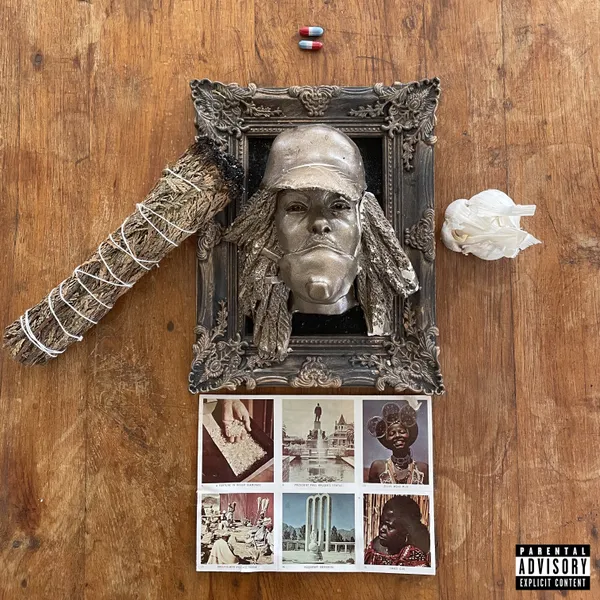Sick! sent me into the stratosphere and left me with an out-of-body experience

Earl Sweatshirt’s cover for his new album, Sick!
Musical and lyrical genius Earl Sweatshirt released a one-of-a-kind throwback album that others could only attempt. A necessarily nostalgic memento from the now disbanded rap group, Odd Future, was taken and revamped by Sweatshirt in Sick!
First appearing on the rap scene in 2008, Sweatshirt is known for his profound passion for true alternative rap; it is the same reason Sweatshirt’s loyal fans still love and support him today. Although a percentage of his newer fan base is too young to remember the prime of Odd Future’s career—or haven’t heard of them in the first place—they’re finally picking up on his timeless style that never fails to pique interest globally.
I appreciate that Sweatshirt has never switched genres entirely. Pop icons like Britney Spears, Demi Lovato, Kesha, and Lady Gaga have changed their style of music to make a comeback after being dormant for years. Needless to say, it didn’t work the way those music legends hoped when they threw all their talent and ingenuity into something new.
Sweatshirt made a few tweaks here and there but never rebranded himself entirely. For over a decade, the “underground” rap phenomenon has steadily risen through the ranks to a comfortable spot for both him and his diverse fan demographic.
Sick! is a long-anticipated album that raises the known standards of alternative rap and is a modern-day Odd Future album.
10. “Tabula Rasa” (feat. Armand Hammer) (track 5)
Tabula Rasa: the theory that individuals are born without built-in mental content, and therefore all knowledge comes from experience or perception (Wikipedia).
“Tabula Rasa” is the worst song on the album, but I use that term lightly. Sick! has no basic beats that sound like a musical atrocity, but the supermarket-esque production of the final product isn’t a flare that should’ve been added. I adore Sweatshirt’s nostalgic time capsules that are his songs, but not in the way that reminds me of the times I got lost in Kingma’s Market. Armand Hammer was more of a slight inclusion rather than a feature. It was somewhat of an enjoyable listen but, rightfully, didn’t deserve a spot on my playlist of almost 2,000 songs.
9. “Fire in the Hole” (track 10)
The last song on any album should reflect what it was about. It should reintroduce recurring themes and tones that aren’t foreign to the album. However, “Fire in the Hole” wasn’t the perfect wrap-up song to my new comfort album. Like “Tabula Rasa,” it sounded too estranged from the rest of the album—not typically an ideal track to have as the last song. The album ended with a soft piano moment, which was nice, but it wasn’t the right conclusion. Despite its unfit manner for a final track in terms of sound, the lyrics were well thought out. “Fire in the Hole” created the illusion that Sweatshirt was just letting everything go and pouring it onto me. It connected me one last time before the twenty-four-minute album finished.
8. “God Laughs” (track 8)
At this point, it gets hard to accurately rank the songs. At first glance, the placement of “God Laughs” gives the impression that it sucked. It didn’t. In fact, the song was a simple melody that sounded like storm clouds before the impending weather hits a small town. The tone in his voice is therapeutic in the oddest way. “God Laughs” is Sweatshirt conveying his emotions once more, and there shouldn’t be anything therapeutic about it at all, but alas. Sweatshirt was talking rather than singing, something that a fellow musical genius and ex-member of Odd Future, Frank Ocean, has an interest in.
7. “Titanic” (track 9)
Just like the name suggests, “Titanic” has some references to the British ship that crashed into an iceberg in the Atlantic Ocean, but that isn’t what makes the song stand out from the rest. The unique beats and classic vocals were soothing to me, and the spunky undertones were the perfect flare, unlike the piano ending in “Fire in the Hole” or the Kingma’s Market type-beat in “Tabula Rasa.” It was a little average, but the trip that is the music is addictive and unparalleled by any artist.
6. “Lye” (track 6)
Controversial, but “Lye” wasn’t the best song on the album. The dark-brown song encapsulates the rusty feelings of the trumpet incorporation that oddly reminded me of his older song, “Burgundy.” But really, “Lye” is one of his more popular songs that I really like. However, the title doesn’t go with its definition at all. Lye is a solution used for cleaning, but nowhere in the album did it mention cleaning anything in his life. The word is fun to say, but I don’t entirely understand why it’s the title. That’s my only beef with the song, which really has nothing to do with the track, but it’s still annoying. “Lye” is a song that I’d have to be in the right mood to listen to because it’s on the border of being classy and flashy.
5. “2010” (track 2)
This is the Odd Future rap that I’ve been longing to hear more of. This is the real throwback song, and the title actually makes sense. Allusions are dotted throughout the stanzas that this mastermind created, such as Liz Claiborne, the Olympics, and “Poker Face” by Lady Gaga. The actual music behind the vocals sounds like the Wii Menu that has been played with and its pitch adjusted. The rectangular console raised me, as well as the bean bags I sat on and the smell of a cold basement. “2010” wasn’t a song that just had a title slapped onto it and shoved into the album. It truly deserves its spot as his fifth most popular song, according to Apple Music.
4. “Sick!” (track 3)
A classic: a song title that matches the album name. “Sick!” is still a very clear Odd Future reference, but that’s perfect. It connects with the name of an album that is very clearly a modern glimpse of what the group would produce if they were still around. The vocals are a little sloppy and mumbly, but it’s tolerable. It’s the soft, yet intense, beat that wrangles my spacey brain and keeps it content for a few minutes. “Sick!” makes me sad that Odd Future isn’t producing any music now, but otherwise, it was a pretty sick song that will definitely make any listener feel like the main character in a low-budget indie film.
3. “Old Friend” (track 1)
Sweatshirt knew what he was doing by having “Old Friend” as his opening track. The obvious title, the feeling I know all too well, is an Odd Future reference. Sweatshirt is reminiscing on his music and rap group from a decade ago that would have changed the rap scene if they were still a group. They helped popularize the alternative rap style we know and love, but it isn’t at all the same rap style that would be found in a teenage boy’s “pre-game” playlist. No Lil Baby or NBA YoungBoy kind of nonsense. This is rap, and Sweatshirt had no problem displaying the power he holds in the scene. Besides Sweatshirt basically obliterating those new “rap stars” with this album, this song reveals how deep friendships and connections can be after years of disbandment.
2. “Vision” (feat. Zelooperz) (track 4)
A close second, but “Vision” ultimately takes the silver medal. There aren’t any Odd Future references from what I can think of, but this is more of an experimental jam that Sweatshirt was having fun with. With exploring new realms of rap and pushing the limits of music comes failures and masterpieces. This was a masterpiece. The hype should be focused on “Vision,” rather than “Lye,” because this song can easily win any rap bracket with its clever lyrics that he stunts and the different approach to the beats and snares.
1. “Lobby (int)” (track 7)
The gold medalist, the song that outdoes them all, the song that is criminally underrated, “Lobby (int)”—talk about a main character moment. If I never need to drown the voice of somebody who is getting on my nerves, this, this right here, is my go-to. There have been songs that have truly stunned me, but nothing compares to “Lobby (int).” It’s indescribable. She’s perfect. Nothing, no words, just the fact that it was added to my monster playlist, but it was also added to my smaller playlist of 40 songs that I am always in the mood for.
On Jan. 14, Sweatshirt released this album without knowing what a wide-reaching impact it would have. Sweatshirt knows what he is doing, and he has perfectly created a timeless project that fans like me will adore for years to come.

For a third round, Sydney returns to write for The Central Trend as a junior. During the summer, she attended the Washington Journalism and Media Conference...


























































































